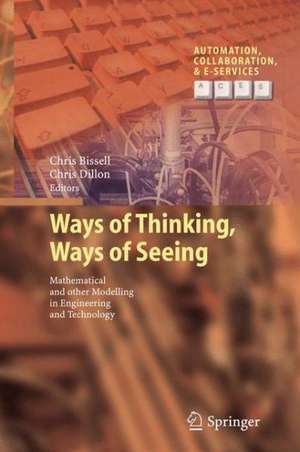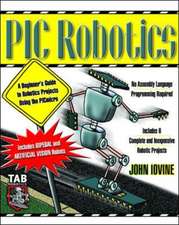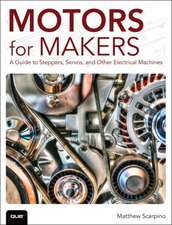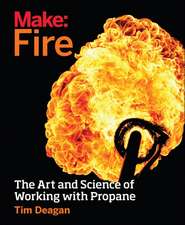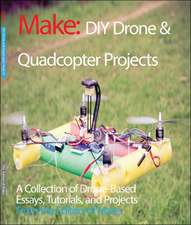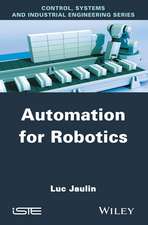Ways of Thinking, Ways of Seeing: Mathematical and other Modelling in Engineering and Technology: Automation, Collaboration, & E-Services, cartea 1
Editat de Chris Bissell, Chris Dillonen Limba Engleză Paperback – 13 apr 2014
• the role of language: the models developed for engineering design have resulted in new ways of talking about technological systems
• communities of practice: related to the previous point, particular engineering communities have particular ways of sharing and developing knowledge
• graphical (re)presentation: engineers have developed many ways of reducing quite complex mathematical models to more simple representations
• reification: highly abstract mathematical models are turned into ‘objects’ that can be manipulated almost like components of a physical system
• machines: not only the currently ubiquitous digital computer, but also older analogue devices – slide rules, physical models, wind tunnels and other small-scale simulators, as well as mechanical, electrical and electronic analogue computers
• mathematics and modelling as a bridging tool between disciplines
This book studies primarily modelling in technological practice. It is worth noting that models of the type considered in the book are not always highly valued in formal engineering education at university level, which often takes an “applied science” approach close to that of the natural sciences (something that can result in disaffection on the part of students). Yet in an informal context, such as laboratories, industrial placements, and so on, a very different situation obtains. A number of chapters considers such epistemological aspects, as well as the status of different types of models within the engineering education community.
The book will be of interest topractising engineers and technologists; sociologists of science and technology; and historians and philosophers of science and mathematics. It will also be written in a way that will be accessible to non-specialists.
| Toate formatele și edițiile | Preț | Express |
|---|---|---|
| Paperback (1) | 942.31 lei 6-8 săpt. | |
| Springer Berlin, Heidelberg – 13 apr 2014 | 942.31 lei 6-8 săpt. | |
| Hardback (1) | 946.55 lei 6-8 săpt. | |
| Springer Berlin, Heidelberg – 4 feb 2012 | 946.55 lei 6-8 săpt. |
Preț: 942.31 lei
Preț vechi: 1149.16 lei
-18% Nou
Puncte Express: 1413
Preț estimativ în valută:
180.33€ • 195.81$ • 151.48£
180.33€ • 195.81$ • 151.48£
Carte tipărită la comandă
Livrare economică 22 aprilie-06 mai
Preluare comenzi: 021 569.72.76
Specificații
ISBN-13: 9783642430428
ISBN-10: 3642430422
Pagini: 248
Ilustrații: XIV, 234 p.
Dimensiuni: 155 x 235 x 13 mm
Greutate: 0.35 kg
Ediția:2012
Editura: Springer Berlin, Heidelberg
Colecția Springer
Seria Automation, Collaboration, & E-Services
Locul publicării:Berlin, Heidelberg, Germany
ISBN-10: 3642430422
Pagini: 248
Ilustrații: XIV, 234 p.
Dimensiuni: 155 x 235 x 13 mm
Greutate: 0.35 kg
Ediția:2012
Editura: Springer Berlin, Heidelberg
Colecția Springer
Seria Automation, Collaboration, & E-Services
Locul publicării:Berlin, Heidelberg, Germany
Public țintă
ResearchCuprins
Creating reality.- Dimensional analysis and dimensional reasoning.- Models: what do engineers see in them?.- Metatools for information engineering design.- Early computational modelling: physical models, electrical analogies and analogue computers.- Expanding the concept of ‘model’: the transfer from technological to human domains within systems.- Visualisations for understanding complex economic systems.- The inner world of models and its epistemic diversity: infectious disease and climate modelling.- Modelling with experience: construal and construction for software.
Textul de pe ultima copertă
This fascinating book examines some of the characteristics of technological/engineering models that are likely to be unfamiliar to those who are interested primarily in the history and philosophy of science and mathematics, and which differentiate technological models from scientific and mathematical ones. Themes that will be highlighted include:
• the role of language: the models developed for engineering design have resulted in new ways of talking about technological systems
• communities of practice: related to the previous point, particular engineering communities have particular ways of sharing and developing knowledge
• graphical (re)presentation: engineers have developed many ways of reducing quite complex mathematical models to more simple representations
• reification: highly abstract mathematical models are turned into ‘objects’ that can be manipulated almost like components of a physical system
• machines: not only the currently ubiquitous digital computer, but also older analogue devices – slide rules, physical models, wind tunnels and other small-scale simulators, as well as mechanical, electrical and electronic analogue computers
• mathematics and modelling as a bridging tool between disciplines
This book studies primarily modelling in technological practice. It is worth noting that models of the type considered in the book are not always highly valued in formal engineering education at university level, which often takes an “applied science” approach close to that of the natural sciences (something that can result in disaffection on the part of students). Yet in an informal context, such as laboratories, industrial placements, and so on, a very different situation obtains. A number of chapters will consider such epistemological aspects, as well as the status of different types of models within the engineering education community.
• the role of language: the models developed for engineering design have resulted in new ways of talking about technological systems
• communities of practice: related to the previous point, particular engineering communities have particular ways of sharing and developing knowledge
• graphical (re)presentation: engineers have developed many ways of reducing quite complex mathematical models to more simple representations
• reification: highly abstract mathematical models are turned into ‘objects’ that can be manipulated almost like components of a physical system
• machines: not only the currently ubiquitous digital computer, but also older analogue devices – slide rules, physical models, wind tunnels and other small-scale simulators, as well as mechanical, electrical and electronic analogue computers
• mathematics and modelling as a bridging tool between disciplines
This book studies primarily modelling in technological practice. It is worth noting that models of the type considered in the book are not always highly valued in formal engineering education at university level, which often takes an “applied science” approach close to that of the natural sciences (something that can result in disaffection on the part of students). Yet in an informal context, such as laboratories, industrial placements, and so on, a very different situation obtains. A number of chapters will consider such epistemological aspects, as well as the status of different types of models within the engineering education community.
Caracteristici
Fascinating book examining the characteristics of technological/engineering models Shows the role of mathematics and modelling as a bridging tool between disciplines Written by leading experts in the field
